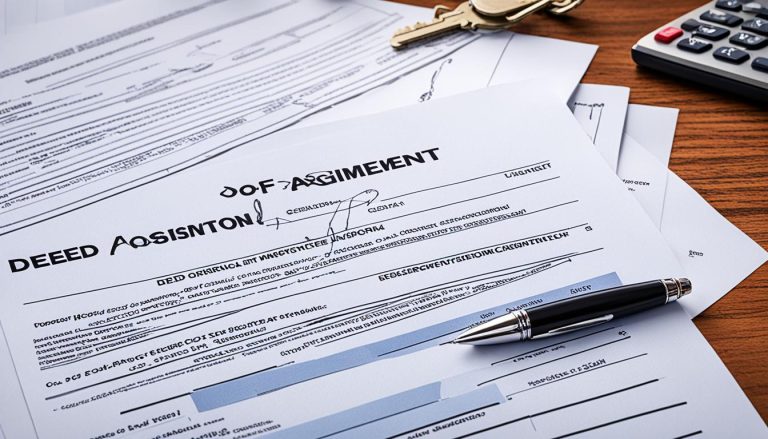A deed of appropriation, also known as an appropriation deed, is a legal document that plays a crucial role in the process of distributing a deceased person’s estate. It allows Personal Representatives (PRs) to allocate specific assets, such as property or shares, to beneficiaries in satisfaction of their inheritance.
The deed of appropriation offers an efficient way of distributing assets, particularly when there are multiple residuary beneficiaries involved. Instead of providing cash, PRs have the power to transfer assets directly to the beneficiary. This can streamline the estate administration process and potentially provide tax benefits.
However, it’s important to understand the requirements and considerations involved in the deed of appropriation process. PRs need to obtain consent from relevant parties and consider the overall estate before finalizing the allocations. Proper documentation and adherence to legal regulations are vital to ensure a smooth and legally valid deed of appropriation.
In this article, we will delve deeper into how the deed of appropriation works, the considerations and limitations to be aware of, and provide a case study to illustrate its practical application. We will also explore the value considerations and conclude with the benefits and potential costs associated with executing a deed of appropriation.
How Does Deed of Appropriation Work?
The power of appropriation allows PRs to allocate a specific part of the deceased’s estate to a beneficiary. This can be done through a deed of appropriation, which serves as a property allocation document and a legal instrument for the process. The PRs have the authority to transfer assets, such as shares or property, to the beneficiary instead of providing cash. This allocation is made in satisfaction of the beneficiary’s inheritance under the will. The power of appropriation can only be exercised if it does not prejudice any specific devise or bequest. In some cases, the testator’s will may specify the conditions for appropriation, eliminating the need for additional consents.
Appropriation Process Overview
- Identify the specific assets or part of the estate to be allocated.
- Prepare a deed of appropriation to document the allocation.
- Transfer the assets to the beneficiary.
- Ensure that the allocation does not prejudice any specific devise or bequest.
- Comply with any requirements or conditions specified in the testator’s will.
By following this process, PRs can effectively distribute the deceased’s estate and fulfill the intended inheritance of the beneficiaries.
Considerations and Limitations
When executing a deed of appropriation, there are certain considerations and limitations to be aware of. These requirements ensure that the process is carried out legally and ethically. Here are some key points to keep in mind:
Deed of Appropriation Requirements
In order to execute a successful deed of appropriation, PRs must obtain consent from beneficiaries who are absolutely entitled. Additionally, consent must be obtained from trustees who are not the PRs or the person entitled to the income of any settled legacy, interest, or share. This ensures that all relevant parties are informed and involved in the process.
Deed of Reservation
It is essential to ensure that no specific devise or bequest is prejudiced by the deed of appropriation. This means that the rights and interests of other beneficiaries or specific legatees must not be compromised or overlooked during the allocation of assets. The PRs should carefully review the terms of the will to identify any reservations or restrictions that may apply to the deed of appropriation.
Assets Transfer Paper
When transferring assets through a deed of appropriation, it is important to properly document the transfer. This may involve preparing and executing an assets transfer paper, which clearly outlines the details of the appropriation, including the assets being transferred, the parties involved, and any specific conditions or considerations. The transfer paper serves as a legally binding record of the property allocation.
Deed of Appropriation Time Limit
There may be a time limit for executing a deed of appropriation, depending on the specific circumstances. It is crucial to be aware of any applicable timeframes and ensure that the deed of appropriation is executed within the specified timeframe. Failure to comply with the time limit may result in complications or challenges to the appropriation process.
Limitations Imposed by Tax Regulations
It’s important to note that there may be limitations imposed by tax regulations when it comes to the deed of appropriation. For example, HMRC does not allow the appropriation of an interest in land to a beneficiary for capital gains tax purposes. PRs should consult with tax professionals or legal experts to ensure compliance with tax regulations and avoid any potential tax implications.
By understanding and adhering to these considerations and limitations, PRs can navigate the deed of appropriation process smoothly and ensure that the interests of all parties involved are safeguarded.
Case Study – Deed of Appropriation in Practice
Let’s delve into a real-life case study to gain a practical understanding of how a deed of appropriation works. In this scenario, Horace, the deceased, bequeathed his residuary estate to his son Brian, daughter Sarah, and brother Keith. The estate consisted of diverse assets, including an antique clock, vintage wine, a motor car, and cash held at the bank.
After consulting with the beneficiaries, the Personal Representatives (PRs) decided to appropriate specific assets to each beneficiary based on their interests. The PRs allocated the antique clock to Sarah, the vintage wine to Brian, and the motor car to Keith. The remaining cash at the bank was then distributed proportionally among all the beneficiaries.
This case study vividly showcases the flexibility and efficiency of a deed of appropriation in distributing assets according to the beneficiaries’ unique preferences and interests. By utilizing this legal instrument, the PRs successfully tailored the distribution of assets to suit the individual desires of each beneficiary.

Value Considerations in Deed of Appropriation
In a deed of appropriation, the value of the appropriated asset plays a crucial role in the distribution process. Typically, the value utilized is known as the date of appropriation value. This refers to the assessed value of the asset at the time of transfer. However, it’s essential to note that the testator’s will may provide the personal representatives (PRs) with the discretion to appropriate assets based on their date of death value. This is particularly significant if there has been a substantial fluctuation in the asset’s value between the date of death and the date of appropriation.
When deciding between the date of appropriation value and the date of death value, careful consideration must be given to the potential implications for the inheriting beneficiary. Opting for the date of appropriation value ensures that the beneficiary receives the asset’s current value at the time of distribution. On the other hand, utilizing the date of death value might protect the beneficiary from a significant increase in the asset’s value between the date of death and the date of appropriation. However, it’s crucial to assess the asset’s potential for appreciation or depreciation during this period and the potential impact on the inheriting beneficiary.

The table below outlines the key considerations when determining whether to use the date of appropriation value or the date of death value:
| Value Considerations | Date of Appropriation Value | Date of Death Value |
|---|---|---|
| Current asset value at the time of distribution | ✓ | |
| Protection against significant increase in asset value | ✓ | |
| Asset appreciation or depreciation between date of death and date of appropriation | ✓ | |
| Potential impact on the inheriting beneficiary | ✓ | ✓ |
By carefully evaluating these considerations, PRs can make an informed decision that aligns with the best interests of the beneficiaries and the overall estate distribution process.
Conclusion
A deed of appropriation is a valuable tool in estate administration, allowing PRs to efficiently allocate assets to beneficiaries. It provides flexibility and convenience for distributing the deceased’s estate, particularly when there are multiple residuary beneficiaries. By understanding the requirements and considerations of the deed of appropriation process, individuals can ensure their property affairs are in order.
It’s important to note that the cost of executing a deed of appropriation may vary, depending on the specific circumstances and legal services involved. However, the benefits of a well-executed deed of appropriation can outweigh the costs, providing a smooth transfer of assets and potential tax advantages.
In summary, a deed of appropriation offers numerous benefits in terms of estate administration. It streamlines the allocation of assets, simplifies the distribution process, and allows for potential tax advantages. While there may be some costs associated with executing a deed of appropriation, the overall advantages make it a worthwhile option. By working with legal professionals, individuals can navigate the deed of appropriation process smoothly and ensure the proper transfer of property to beneficiaries.






